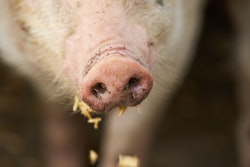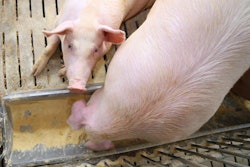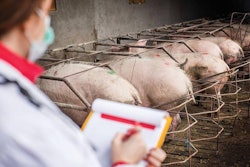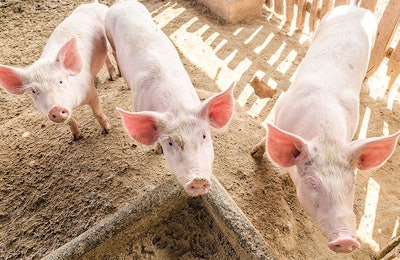
Global movement of feed ingredients calls for an in-feed disease mitigation strategy
Feed and feed ingredients have the potential to harbor devastating bacteria and viruses like porcine epidemic diarrhea (PED) virus, porcine reproductive and respiratory syndrome (PRRS) and African swine fever (ASF). The bacteria and viruses can be transmitted in feed – eventually making their way through the pig’s digestive system and replicating, causing infection.
The global movement of feed ingredients and commodities increases the risk of introducing disease through ingredients when sourced from areas of active disease pressures. The risk of global disease transmission reinforces the need for an in-feed mitigation strategy to help guard against disease threats.
Medium-chain fatty acids (MCFAs) have proven to be a useful biosecurity tool, essentially acting as security guards to protect pigs from bacteria and viruses. Activated MCFAs can begin working in feed, before pigs consume it, to reduce the feed’s pathogen load. After feed consumption, MCFAs continue to work inside the animal to weaken pathogens in the digestive tract.
How MCFAs attack bacteria
When MCFAs contact bacteria, they:
- Degrade the bacterial cell membrane
- Dissociate into the bacterial cell, causing the pH inside the cell to drop
- Block DNA replication of bacterial cells
Let’s take a closer look at the modes of action.
MCFAs are similar in length and structure to the phospholipids that make up bacterial cell walls. They have a head and a tail, which are hydrophilic and hydrophobic, allowing them to slip through the phospholipid layer. They have 6, 8, 10 or 12 carbon atoms; shorter- or longer-chain fatty acids aren’t the right size for the job.
The ability to move through bacterial cell walls allows MCFAs to weaken bacteria in three ways:
- Bacterial cell contents leak out, which weakens the cell.
- The MCFA enters the cell and dissociates, decreasing the cell’s pH. The higher the fatty acid’s pKa, or acid strength, the greater the ability of the acid to lower pH.
- Once the MCFA is inside the cell, it can block DNA replication. To replicate, the virus has to unfold its DNA, but MCFAs intercalate or inserts themselves into the DNA helix and prevent replication.
These actions happen prior to consumption in feed, as well as inside the pig during digestion. In either place, MCFAs help reduce the bacterial load and the strength of the bacterial challenge pigs face.
How MCFAs attack viruses
MCFAs are effective against viruses with an “envelope” outer layer, including PEDv and PRRS.
Enveloped viruses have a bilipid layer similar to the bacterial cell membrane. The lipid layer has receptors designed to connect to cells inside the animal. When the receptors connect, the envelope unfolds and releases its viral contents, allowing the virus to replicate inside the animal and cause an infection.
MCFAs work in the feed before an animal consumes it. Viruses can hide in feed, but they cannot replicate in it as they can inside the pig’s body. So, when MCFAs contact viruses in feed, they break through the envelope lining, causing the release of viral material and making it inactive before it can harm the animal.
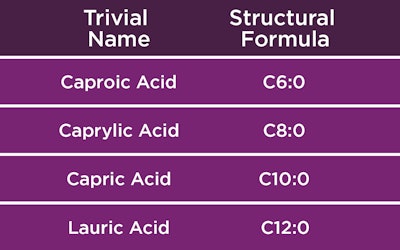 Medium-chain fatty acids have between 6 and 12 carbon atoms. They support feed biosecurity because their length and molecular structure allows them to weaken some bacteria or viruses. | Courtesy PMI Nutrition
Medium-chain fatty acids have between 6 and 12 carbon atoms. They support feed biosecurity because their length and molecular structure allows them to weaken some bacteria or viruses. | Courtesy PMI NutritionDifferences between fatty acids
Activated MCFAs are free fatty acids, meaning they work instantly. Other sources of MCFAs – like triglycerides or salts – must be broken apart for the MCFAs to become activated.
Different bacteria and viruses are susceptible to different lengths of MCFAs. Feeding a strategic combination of lengths (6, 8, 10 and 12 carbons) provides broad-spectrum support to the pig. Feeding a single MCFA could work against some disease challenges, but a blend of offers a more consistent response and the most insurance.
A strategic blend of activated MCFAs can also lower the inclusion rate of the feed additive to help keep diets efficient. Comparatively, triglycerides must be fed at a higher inclusion rate to be active in the gut. And, while salt is fed at a lower inclusion rate than triglycerides, palatability can be an issue because MCFAs in salt form can inhibit feed intake because they taste soapy.
A strong biosecurity program protects pigs at every possible point of entry to the farm, including feed and feed ingredients. MCFAs are effective as feed security guards because they have multiple modes of action to protect pigs from a broad spectrum of disease threats. Activated MCFAs fight pathogens in feed before it’s consumed and continue to protect the pig during digestion.


